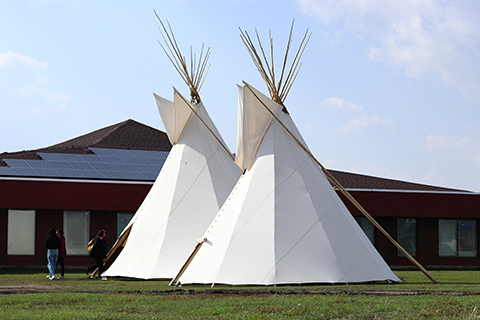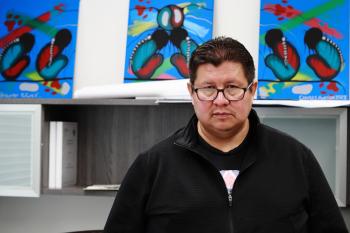Image Caption
Summary
Windspeaker.com
Development is moving fast in Kehewin Cree Nation. With project after project, the First Nation is erasing its ‘lost years,’ when federal officials assigned control of the Nation’s finances to an accounting firm.
For Kimberly John, this means returning home after 19 years living away from her community.
John will move from the nearby town of Elk Point into one of the 22 pre-built houses expected to be delivered in early 2024 through the Canadian government’s Rapid Housing Initiative.
“Moving home also means moving closer to work, being more connected back to my community,” said John, who works for the Canadian Human Rights Tribunal program.

And students are returning to the kino kamasihk kiskinohamatokamik school, which had its grand opening in 2022. Plans to connect more than 60 homes to water lines from the water treatment plant are being finalized.
It’s a familiar scene in Alberta, where for the past 10 years, communities have been restarting stalled housing projects, ending long-term boil water advisories, and relaunching social programs that were gutted to repay debt. These were the legacy of the Default Prevention and Management Policy (DPMP), a federal program that impacted at least 27 of 45 First Nations in the province.
Since at least the 1980s, the policy imposed a range of financial intervention remedies on First Nations struggling with their financial circumstances. Though Ottawa committed to ending the use of DPMP in 2017, it remains in place in a handful of First Nations across Canada. The intervention program appears to have reached its peak in Alberta in 2003, when 22 First Nations bands and organizations in Alberta were forced into some form of remedial management.
Research by Dr. Shiri Pasternak in Toronto, gathered through 10 years of requests from the ministry now called Indigenous Services Canada (ISC), revealed, however, that community conditions grew measurably worse in most First Nations placed under the highest levels of the policy, third-party management and co-management.
For First Nations in Alberta, the cumulative challenges — and their costs — continued for decades.
An eight per cent debt service ratio — a modest figure compared to amounts commonly shouldered by municipal, provincial and federal governments — was enough to automatically trigger outside intervention.
Under co-management, a First Nation was required to hire what Ottawa called a “recipient appointed” manager to oversee financial action plans. In third-party management, the most serious level of intervention, an ISC-appointed financial advisor administers all government funding.
Though meant to be a temporary measure “to ensure the continued delivery of programs and services to community members,” according to ISC, First Nations subject to DPMP interventions were routinely stuck in cycles of default and mandated repayment plans that dragged on for years. An evaluation of the intervention policy completed by INAC found that four per cent of Alberta First Nations had been under some form of intervention for 10 or more years as of 2010.
Default managers were often paid between $160,000 and $420,000 per year, with the Nation itself being forced to foot the bill.
Archival research and interviews undertaken through a partnership between MacEwan University, Windspeaker, First Nations University and Toronto Metropolitan University help fill in the gaps in records and reveal some of that legacy in stark numbers.
First Nations under imposed financial intervention were more likely to experience problems with crowded housing as compared to those Nations where no financial interventions were made. Both third-party and co-managed First Nations were also more likely to have homes in need of major repair than those that retained control over their own finances, according to an analysis of data from Statistics Canada.
First Nations across Canada had similar experiences, the data shows. Some leaders, including Chief Wilfred King of Gull Bay First Nation in Ontario, have said that affected communities should file a class-action lawsuit.
Band administrator William John thinks there would be appetite for the idea in Alberta, because communities are still grappling with the fallout from the intervention program while the people responsible for its implementation have moved on, including federal politicians, bureaucrats and the accounting firm managers appointed to implement the scheme.
“When you really think about it, some of those people that were involved in some of those decisions have gone on to other things or maybe they’re drawing on a pension,” John said.
“Like my uncle from Saskatchewan said, ‘I don’t like the fact that someone will retire because I have a Treaty number’.”

Kehewin had been under recipient managed default plans in years prior. But a dispute between the Nation and a construction company over costs for renovation of an Elders’ Lodge brought the project to a halt.
It was Ottawa itself that tipped Kehewin across the debt threshold by pulling the ministerial loan guarantee for the Elders’ lodge, said John.
“When they did that, that essentially meant we were put directly into third-party management,” he said.
On March 9, 2010, INAC appointed AAC Aboriginal Corp. as the third-party manager, but nobody from Kehewin was informed of the appointment until 10 days later.
In April, the AAC team arrived and set up an office in Bonnyville, a town some 25 kilometres away from Kehewin. From there they would direct financial decisions for the Nation.
The Nation tried but failed to challenge the imposition in court, arguing that Ottawa had a duty to consult.
Reviewing past case law, federal court Justice Michael J. Phelan determined “there is no link between the appointment of a third-party manager and native self-government.”
“Even if there was a duty to consult, it would be at the very low end of the consultation spectrum because the strength of the claim to Aboriginal rights asserted is weak and the potential adverse effect is temporary,” he wrote in 2011.
AAC’s contract gave the firm power over all of Kehewin’s funds received from INAC, and a mandate to redirect the money to meet INAC’s goals, which prioritized deficit control over capital spending.
As hammers fell silent in Kehewin, the number of homes needing major repairs climbed, from 44 per cent in 2006 to 50 per cent in 2011, to 55 per cent in 2016.
Talks between Kehewin and the federal government about building a new school had been ongoing since 2006, William John said. But under third-party management, these promising nation-to-nation negotiations were rerouted through ISC intermediaries and the project was effectively shelved.
Plans for water treatment upgrades were postponed, leading to a boil water advisory that would remain in place for nearly a decade.
The policy’s downstream impacts continued to be felt in the community long after Kehewin regained control of its finances in 2014.
“The greater the debt recovery, the more likely it is to affect the maintenance and operations of infrastructure, housing, and water,” explained former Chief Brenda John-Vanguard, who was elected in 2015.
Cascading events were particularly severe on housing. With funds redirected to debt servicing, housing construction slowed, disrupting funding from the Canadian Mortgage and Housing Corporation, “which flowed funding based upon housing completions,” John-Vanguard said in an email.
“Housing is a fundamental service which when disrupted leads to other social problems. Homelessness or inadequate housing leads to unemployment, indignity, addictions, mental health issues, and physical health issues, not to speak of the residual effects of residential schools,” John-Vanguard added.
When Kehewin paid down $2 million in debt, and was removed from third-party management, it did so because of own-source revenue streams the Nation had outside of the federal funding agreement, John asserted.
“We demonstrated outside of the third-party parameters that we were capable of taking care of our bills,” John said.
John is proud of the progress Kehewin Cree Nation has made in the last decade. Once freed from third-party, plans for the school resumed, with construction being completed during the pandemic and the school opening in full last fall.
After the construction of a new water treatment plant, the boil water advisory in the community was finally lifted in 2021 – the last remaining long-term drinking water advisory in the province.
All of these changes came after the departure of the third-party managers, John points out.
“I can't sit here and say if any foundations were laid (during third-party management),” he said, noting that conversations with INAC about funding the new school began in the year after Kehewin regained control of its finances.
“I wouldn’t want to give (the managers) too much credit,” he laughed. “Maybe five per cent.”
Between 2004 and 2008, federal financial data shows there was no change in the number of Alberta First Nations with a cumulative operating deficit, despite the markedly increased use of financial interventions.
This investigation was produced in partnership with the Accounting for Colonialism Journalism Consortium
Reporter: Brett McKay, MacEwan University
Project director: Patti Sonntag, investigative journalist
Supervising faculty: Steve Lillebeun, MacEwan University and Patricia Elliott, First Nations University of Canada
Researchers: Shiri Pasternak and Ryan Moore, Toronto Metropolitan University

